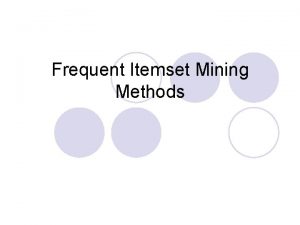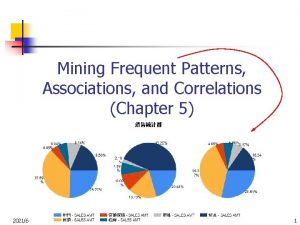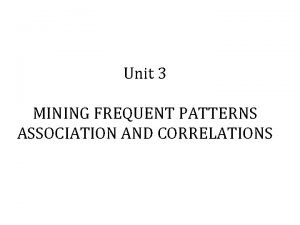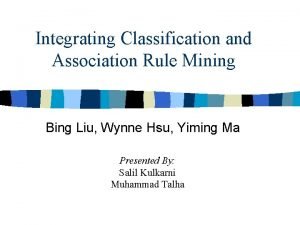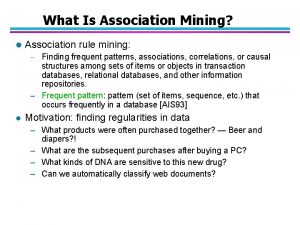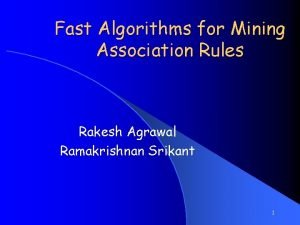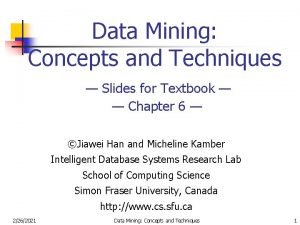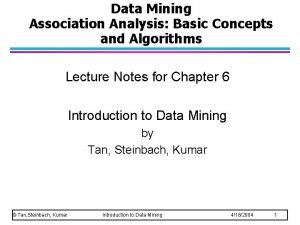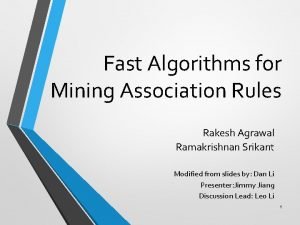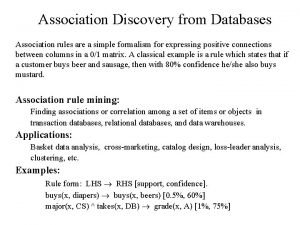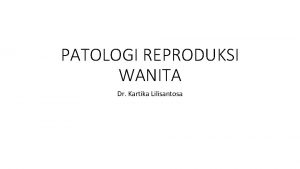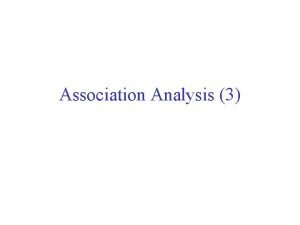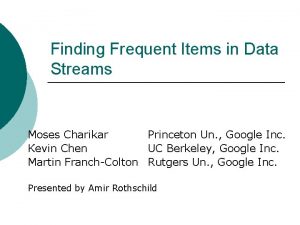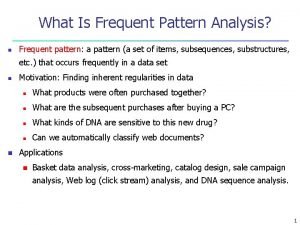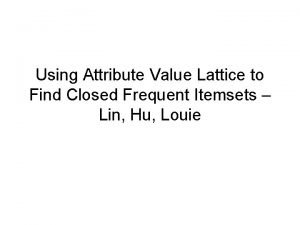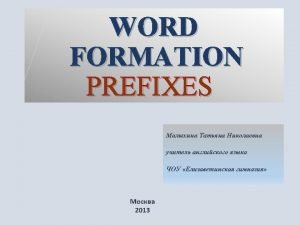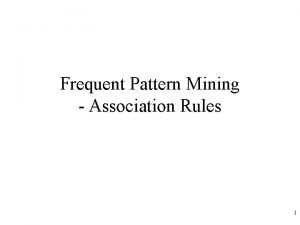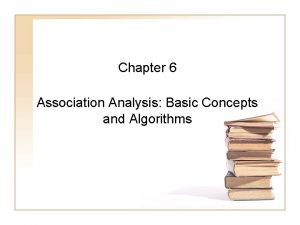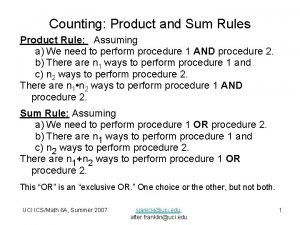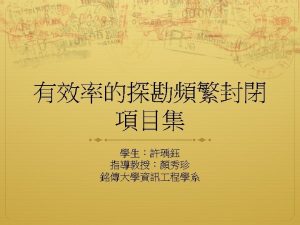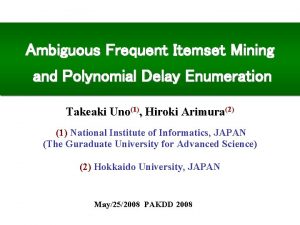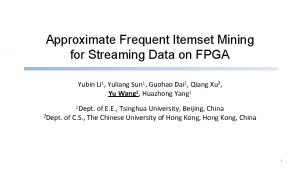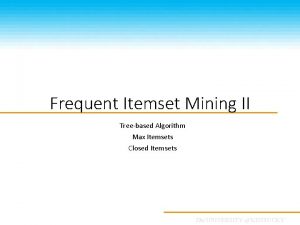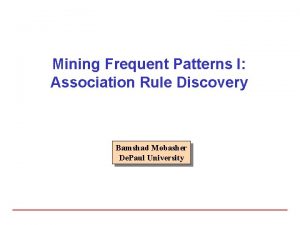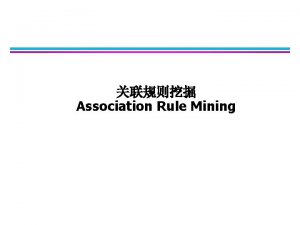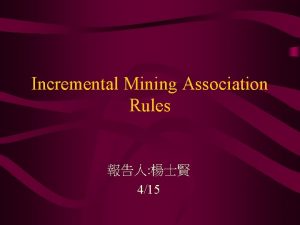Frequent Itemset Mining Association Rules Association Rule Discovery





















































- Slides: 53

Frequent Itemset Mining & Association Rules

Association Rule Discovery Supermarket shelf management – Market-basket model: �Goal: Identify items that are bought together by sufficiently many customers �Approach: Process the sales data collected with barcode scanners to find dependencies among items �A classic rule: § If someone buys diaper and milk, then he/she is likely to buy beer § Don’t be surprised if you find six-packs next to diapers! 6/4/2021 2

The Market-Basket Model �A large set of items Input: § e. g. , things sold in a supermarket �A large set of baskets § Each basket is a small subset of items § e. g. , the things one customer buys on one day Output: Rules Discovered: {Milk} --> {Coke} {Diaper, Milk} --> {Beer} �Discover association rules: People who bought {x, y, z} tend to buy {v, w} § Amazon! 6/4/2021 3

More generally �A general many-to-many mapping (association) between two kinds of things § But we ask about connections among “items”, not “baskets” �Items and baskets are abstract: § For example: § Items/baskets can be products/shopping basket § Items/baskets can be words/documents § Items/baskets can be basepairs/genes § Items/baskets can be drugs/patients 6/4/2021 4

Applications – (1) �Items = products; Baskets = sets of products someone bought in one trip to the store �Real market baskets: Chain stores keep TBs of data about what customers buy together § Tells how typical customers navigate stores, lets them position tempting items: § Apocryphal story of “diapers and beer” discovery § Used to position potato chips between diapers and beer to enhance sales of potato chips �Amazon’s people who bought X also bought Y 6/4/2021 5

Applications – (2) �Baskets = sentences; Items = documents in which those sentences appear § Items that appear together too often could represent plagiarism § Notice items do not have to be “in” baskets �Baskets = patients; Items = drugs & side-effects § Has been used to detect combinations of drugs that result in particular side-effects § But requires extension: Absence of an item needs to be observed as well as presence 6/4/2021 6

Outline First: Define Frequent itemsets Association rules: Confidence, Support, Interestingness Then: Algorithms for finding frequent itemsets Finding frequent pairs A-Priori algorithm PCY algorithm 6/4/2021 7

Frequent Itemsets �Simplest question: Find sets of items that appear together “frequently” in baskets �Support for itemset I: Number of baskets containing all items in I § (Often expressed as a fraction of the total number of baskets) �Given a support threshold s, then sets of items that appear in at least s baskets are called frequent itemsets 6/4/2021 Support of {Beer, Bread} = 2 8

Example: Frequent Itemsets �Items = {milk, coke, pepsi, beer, juice} �Support threshold = 3 baskets B 1 = {m, c, b} B 3 = {m, b} B 5 = {m, p, b} B 7 = {c, b, j} B 2 = {m, p, j} B 4 = {c, j} B 6 = {m, c, b, j} B 8 = {b, c} �Frequent itemsets: {m}, {c}, {b}, {j}, {m, b} , {b, c} , {c, j}. 6/4/2021 9

Association Rules �Association Rules: If-then rules about the contents of baskets �{i 1, i 2, …, ik} → j means: “if a basket contains all of i 1, …, ik then it is likely to contain j” �In practice there are many rules, want to find significant/interesting ones! �Confidence of association rule is the probability of j given I = {i 1, …, ik} 6/4/2021 10

Interesting Association Rules �Not all high-confidence rules are interesting § The rule X → milk may have high confidence for many itemsets X, because milk is just purchased very often (independent of X) and the confidence will be high �Interest of an association rule I → j: difference between its confidence and the fraction of baskets that contain j § Interesting rules are those with high positive or negative interest values (usually above 0. 5) 6/4/2021 11

Example: Confidence and Interest B 1 = {m, c, b} B 3 = {m, b} B 5 = {m, p, b} B 7 = {c, b, j} B 2 = {m, p, j} B 4= {c, j} B 6 = {m, c, b, j} B 8 = {b, c} �Association rule: {m, b} →c § Support = 2 § Confidence = 2/4 = 0. 5 § Interest = |0. 5 – 5/8| = 1/8 § Item c appears in 5/8 of the baskets § Rule is not very interesting! 6/4/2021 12

Finding Association Rules �Problem: Find all association rules with support ≥s and confidence ≥c § Note: Support of an association rule is the support of the set of items in the rule (left and right side) �Hard part: Finding the frequent itemsets! § If {i 1, i 2, …, ik} → j has high support and confidence, then both {i 1, i 2, …, ik} and {i 1, i 2, …, ik, j} will be “frequent” 6/4/2021 13

Mining Association Rules �Step 1: Find all frequent itemsets I § (we will explain this next) �Step 2: Rule generation § For every subset A of I, generate a rule A → I A § Since I is frequent, A is also frequent § Variant 1: Single pass to compute the rule confidence § confidence(A, B→C, D) = support(A, B, C, D) / support(A, B) § Variant 2: § Observation: If A, B, C→D is below confidence, so is A, B→C, D § Can generate “bigger” rules from smaller ones! § Output the rules above the confidence threshold 6/4/2021 14

Example B 1 = {m, c, b} B 3 = {m, c, b, n} B 5 = {m, p, b} B 7 = {c, b, j} B 2 = {m, p, j} B 4= {c, j} B 6 = {m, c, b, j} B 8 = {b, c} �Support threshold s = � 1) Frequent itemsets: 3, confidence c = 0. 75 § {b, m} {b, c} {c, m} {c, j} {m, c, b} � 2) Generate rules: § b→m: c=4/6 § m→b: c=4/5 6/4/2021 b→c: c=5/6 … b, c→m: c=3/5 b, m→c: c=3/4 b→c, m: c=3/6 15

Compacting the Output �To reduce the number of rules we can post-process them and only output: § Maximal frequent itemsets: No immediate superset is frequent § Gives more pruning or § Closed itemsets: No immediate superset has the same support (> 0) § Stores not only frequent information, but exact supports/counts 6/4/2021 16

Example: Maximal/Closed Support Maximal(s=3) Closed A 4 No No B 5 No Yes C 3 No No AB 4 Yes AC 2 No No BC 3 Yes ABC 2 No Yes 6/4/2021 Frequent, but superset BC also frequent. Frequent, and its only superset, ABC, not freq. Superset BC has same support. Its only superset, ABC, has smaller support. 17

Finding Frequent Itemsets

Itemsets: Computation Model �Back to finding frequent itemsets �Typically, data is kept in flat files rather than in a database system: § Stored on disk § Stored basket-by-basket § Baskets are small but we have many baskets and many items § Expand baskets into pairs, triples, etc. as you read baskets § Use k nested loops to generate all sets of size k Note: We want to find frequent itemsets. To find them, we have to count them. To count them, we have to enumerate them. 6/4/2021 Item Item Item Etc. Items are positive integers, and boundaries between baskets are – 1. 19

Computation Model �The true cost of mining disk- Item resident data is usually the number of disk I/Os �In practice, association-rule Item algorithms read the data in passes – all baskets read in turn Item Item Etc. �We measure the cost by the number of passes an algorithm makes over the data 6/4/2021 Items are positive integers, and boundaries between baskets are – 1. 20

Main-Memory Bottleneck �For many frequent-itemset algorithms, main-memory is the critical resource § As we read baskets, we need to count something, e. g. , occurrences of pairs of items § The number of different things we can count is limited by main memory § Swapping counts in/out is a disaster 6/4/2021 21

Finding Frequent Pairs �The hardest problem often turns out to be finding the frequent pairs of items {i 1, i 2} § Why? Freq. pairs are common, freq. triples are rare § Why? Probability of being frequent drops exponentially with size; number of sets grows more slowly with size �Let’s first concentrate on pairs, then extend to larger sets �The approach: § We always need to generate all the itemsets § But we would only like to count (keep track) of those itemsets that in the end turn out to be frequent 6/4/2021 22

Naïve Algorithm �Naïve approach to finding frequent pairs �Read file once, counting in main memory the occurrences of each pair: § From each basket of n items, generate its n(n-1)/2 pairs by two nested loops �Fails if (#items)2 exceeds main memory § Remember: #items can be 100 K (Wal-Mart) or 10 B (Web pages) § Suppose 105 items, counts are 4 -byte integers § Number of pairs of items: 105(105 -1)/2 5*109 § Therefore, 2*1010 (20 gigabytes) of memory needed 6/4/2021 23

Counting Pairs in Memory Two approaches: �Approach 1: Count all pairs using a matrix �Approach 2: Keep a table of triples [i, j, c] = “the count of the pair of items {i, j} is c. ” § If integers and item ids are 4 bytes, we need approximately 12 bytes for pairs with count > 0 § Plus some additional overhead for the hashtable 6/4/2021 24

Comparing the 2 Approaches 4 bytes per pair Triangular Matrix 6/4/2021 12 per occurring pair Triples 25

Comparing the two approaches �Approach 1: Triangular Matrix § n = total number items § Count pair of items {i, j} only if i<j § Keep pair counts in lexicographic order: § {1, 2}, {1, 3}, …, {1, n}, {2, 3}, {2, 4}, …, {2, n}, {3, 4}, … § Pair {i, j} is at position: (i – 1)(j– i) + j – 1 § Total number of pairs n(n – 1)/2; total bytes= O(n 2) § Triangular Matrix requires 4 bytes per pair �Approach 2 uses 12 bytes per occurring pair (but only for pairs with count > 0) �Approach 2 beats Approach 1 if less than 1/3 of possible pairs actually occur 6/4/2021 26

Comparing the two approaches �Approach 1: Triangular Matrix § n = total number items § Count pair of items {i, j} only if i<j § Keep pair counts in lexicographic order: Problem is if we have too § Pair {i, j} is at position (i – 1)(n– i/2) + j – 1 many items so the pairs § Total number of pairs n(n – 1)/2; total bytes= 2 n 2 do not fitrequires into memory. § Triangular Matrix 4 bytes per pair § {1, 2}, {1, 3}, …, {1, n}, {2, 3}, {2, 4}, …, {2, n}, {3, 4}, … Can we do better? �Approach 2 uses 12 bytes per occurring pair (but only for pairs with count > 0) �Approach 2 beats Approach 1 if less than 1/3 of possible pairs actually occur 6/4/2021 27

A-Priori Algorithm • • • Monotonicity of “Frequent” Notion of Candidate Pairs Extension to Larger Itemsets

A-Priori Algorithm – (1) �A two-pass approach called A-Priori limits the need for main memory �Key idea: monotonicity § If a set of items I appears at least s times, so does every subset J of I �Contrapositive for pairs: If item i does not appear in s baskets, then no pair including i can appear in s baskets �So, how does A-Priori find freq. pairs? 6/4/2021 29

A-Priori Algorithm – (2) � 6/4/2021 30

Main-Memory: Picture of A-Priori Item counts Frequent items Main memory Counts of pairs of frequent items (candidate pairs) Pass 1 Pass 2 Green box represents the amount of available main memory. Smaller boxes represent how the memory is used. 6/4/2021 31

Detail for A-Priori �You can use the § May save space compared with storing triples �Trick: re-number frequent items 1, 2, … and keep a table relating new numbers to original item numbers 6/4/2021 Item counts Frequent items Old item IDs Counts of pairs Counts of of frequent pairs of items frequent items Main memory triangular matrix method with n = number of frequent items Pass 1 Pass 2 32

Frequent Triples, Etc. �For each k, we construct two sets of k-tuples (sets of size k): § Ck = candidate k-tuples = those that might be frequent sets (support > s) based on information from the pass for k– 1 § Lk = the set of truly frequent k-tuples All items C 1 6/4/2021 Count the items Filter L 1 All pairs of items from L 1 Construct Count the pairs C 2 Filter To be explained L 2 Construct C 3 33

Example ** Note here we generate new candidates by generating Ck from Lk-1 and L 1. But that one can be more careful with candidate generation. For example, in C 3 we know {b, m, j} cannot be frequent since {m, j} is not frequent �Hypothetical steps of the A-Priori algorithm § § § § § 6/4/2021 C 1 = { {b} {c} {j} {m} {n} {p} } Count the support of itemsets in C 1 Prune non-frequent: L 1 = { b, c, j, m } Generate C 2 = { {b, c} {b, j} {b, m} {c, j} {c, m} {j, m} } Count the support of itemsets in C 2 Prune non-frequent: L 2 = { {b, m} {b, c} {c, m} {c, j} } Generate C 3 = { {b, c, m} {b, c, j} {b, m, j} {c, m, j} } ** Count the support of itemsets in C 3 Prune non-frequent: L 3 = { {b, c, m} } 34

A-Priori for All Frequent Itemsets �One pass for each k (itemset size) �Needs room in main memory to count each candidate k–tuple �For typical market-basket data and reasonable support (e. g. , 1%), k = 2 requires the most memory �Many possible extensions: § Association rules with intervals: § For example: Men over 65 have 2 cars § Association rules when items are in a taxonomy § Bread, Butter → Fruit. Jam § Baked. Goods, Milk. Product → Preserved. Goods § Lower the support s as itemset gets bigger 6/4/2021 35

PCY (Park-Chen-Yu) Algorithm • • • Improvement to A-Priori Exploits Empty Memory on First Pass Frequent Buckets

PCY (Park-Chen-Yu) Algorithm �Observation: In pass 1 of A-Priori, most memory is idle § We store only individual item counts § Can we use the idle memory to reduce memory required in pass 2? �Pass 1 of PCY: In addition to item counts, maintain a hash table with as many buckets as fit in memory § Keep a count for each bucket into which pairs of items are hashed § For each bucket just keep the count, not the actual pairs that hash to the bucket! 6/4/2021 37

PCY Algorithm – First Pass FOR (each basket) : FOR (each item in the basket) : add 1 to item’s count; FOR (each pair of items) : New hash the pair to a bucket; in PCY add 1 to the count for that bucket; �Few things to note: § Pairs of items need to be generated from the input file; they are not present in the file § We are not just interested in the presence of a pair, but we need to see whether it is present at least s (support) times 6/4/2021 38

Observations about Buckets �Observation: If a bucket contains a frequent pair, then the bucket is surely frequent �However, even without any frequent pair, a bucket can still be frequent § So, we cannot use the hash to eliminate any member (pair) of a “frequent” bucket �But, for a bucket with total count less than none of its pairs can be frequent s, § Pairs that hash to this bucket can be eliminated as candidates (even if the pair consists of 2 frequent items) �Pass 2: Only count pairs that hash to frequent buckets 6/4/2021 39

PCY Algorithm – Between Passes �Replace the buckets by a bit-vector: § 1 means the bucket count exceeded the support s (call it a frequent bucket); 0 means it did not � 4 -byte integer counts are replaced by bits, so the bit-vector requires 1/32 of memory �Also, decide which items are frequent and list them for the second pass 6/4/2021 40

PCY Algorithm – Pass 2 Count all pairs {i, j} that meet the conditions for being a candidate pair: � 1. Both i and j are frequent items 2. The pair {i, j} hashes to a bucket whose bit in the bit vector is 1 (i. e. , a frequent bucket) � 6/4/2021 Both conditions are necessary for the pair to have a chance of being frequent 41

Main-Memory: Picture of PCY Main memory Item counts Bitmap Hash table for pairs Pass 1 6/4/2021 Frequent items Counts of candidate pairs Pass 2 42

Frequent Itemsets in < 2 Passes • • • Simple Algorithm Savasere-Omiecinski- Navathe (SON) Algorithm Toivonen’s Algorithm

Frequent Itemsets in < 2 Passes �A-Priori, PCY, etc. , take k passes to find frequent itemsets of size k �Can we use fewer passes? �Use 2 or fewer passes for all sizes, but may miss some frequent itemsets § Random sampling § Do not sneer; “random sample” is often a cure for the problem of having too large a dataset. § SON (Savasere, Omiecinski, and Navathe) § Toivonen 6/4/2021 45

Random Sampling (1) �Take a random sample of the market baskets �Run a-priori or one of its improvements § So we don’t pay for disk I/O each time we increase the size of itemsets § Reduce support threshold proportionally to match the sample size Main memory in main memory Copy of sample baskets Space for counts § Example: if your sample is 1/100 of the baskets, use s/100 as your support threshold instead of s. 6/4/2021 46

Random Sampling (2) �To avoid false positives: Optionally, verify that the candidate pairs are truly frequent in the entire data set by a second pass �But you don’t catch sets frequent in the whole but not in the sample § Smaller threshold, e. g. , s/125, helps catch more truly frequent itemsets § But requires more space 6/4/2021 47

SON Algorithm – (1) �SON Algorithm: Repeatedly read small subsets of the baskets into main memory and run an in-memory algorithm to find all frequent itemsets § Note: we are not sampling, but processing the entire file in memory-sized chunks �An itemset becomes a candidate if it is found to be frequent in any one or more subsets of the baskets. 6/4/2021 48

SON Algorithm – (2) �On a second pass, count all the candidate itemsets and determine which are frequent in the entire set �Key “monotonicity” idea: An itemset cannot be frequent in the entire set of baskets unless it is frequent in at least one subset 6/4/2021 49

Toivonen’s Algorithm: Intro Pass 1: �Start with a random sample, but lower the threshold slightly for the sample: § Example: if the sample is 1% of the baskets, use s/125 as the support threshold rather than s/100 �Find frequent itemsets in the sample �Add to the itemsets that are frequent in the sample the negative border of these itemsets: § Negative border: An itemset is in the negative border if it is not frequent in the sample, but all its immediate subsets are § Immediate subset = “delete exactly one element” 6/4/2021 50

Example: Negative Border � {A, B, C, D} is in the negative border if and only if: 1. It is not frequent in the sample, but 2. All of {A, B, C}, {B, C, D}, {A, C, D}, and {A, B, D} are. Negative Border … tripletons doubletons singletons 6/4/2021 Frequent Itemsets from Sample 51

Toivonen’s Algorithm � Pass 1: § Start as in the SON algorithm, but lower the threshold slightly for the sample § Add to the itemsets that are frequent in the sample the negative border of these itemsets � Pass 2: § Count all candidate frequent itemsets from the first pass, and also count sets in their negative border � If no itemset from the negative border turns out to be frequent, then we found all the frequent itemsets. § What if we find that something in the negative border is frequent? § We must start over again with another sample! § Try to choose the support threshold so the probability of failure is low, while the number of itemsets checked on the second pass fits in mainmemory. 6/4/2021 52

If Something in the Negative Border Is Frequent. . . … We broke through the negative border. How far does the problem go? Negative Border tripletons doubletons singletons 6/4/2021 Frequent Itemsets from Sample 53

Theorem: � If there is an itemset S that is frequent in full data, but not frequent in any sample, then the negative border contains at least one itemset that is frequent in the whole. Proof by contradiction: � Suppose not; i. e. ; 1. There is an itemset S frequent in the full data but not frequent in the sample, and 2. Nothing in the negative border is frequent in the full data � Let T be a smallest subset of S that is not frequent in the sample (but every subset of T is) � T is frequent in the whole (S is frequent + monotonicity). � But then T is in the negative border (contradiction) 6/4/2021 54
 Mining frequent itemsets using vertical data format
Mining frequent itemsets using vertical data format Mining frequent patterns associations and correlations
Mining frequent patterns associations and correlations Eclat algorithm
Eclat algorithm Mining frequent patterns without candidate generation
Mining frequent patterns without candidate generation Mining frequent patterns without candidate generation
Mining frequent patterns without candidate generation Mining frequent patterns associations and correlations
Mining frequent patterns associations and correlations Association rule mining tutorial
Association rule mining tutorial Integrating classification and association rule mining
Integrating classification and association rule mining Association rule definition
Association rule definition Association rule mining definition
Association rule mining definition What is association rules
What is association rules Aprioti
Aprioti Fast algorithms for mining association rules
Fast algorithms for mining association rules Association rules in data mining
Association rules in data mining Association rules in data mining
Association rules in data mining Association analysis advanced concepts
Association analysis advanced concepts Association rules in data mining
Association rules in data mining Fast algorithms for mining association rules
Fast algorithms for mining association rules Fast algorithms for mining association rules
Fast algorithms for mining association rules Introduction to data mining and knowledge discovery
Introduction to data mining and knowledge discovery Strip mining vs open pit mining
Strip mining vs open pit mining Chapter 13 mineral resources and mining worksheet answers
Chapter 13 mineral resources and mining worksheet answers Difference between strip mining and open pit mining
Difference between strip mining and open pit mining Difference between text mining and web mining
Difference between text mining and web mining Mining multimedia databases in data mining
Mining multimedia databases in data mining Eck
Eck Unlike traditional production rules, association rules
Unlike traditional production rules, association rules Association discovery
Association discovery Winperl
Winperl Penyebab penyakit benign neoplasm of breast d24
Penyebab penyakit benign neoplasm of breast d24 Crm process in retailing
Crm process in retailing Acebf
Acebf Frequent pattern
Frequent pattern Common suffixes and prefixes
Common suffixes and prefixes Reverse image search
Reverse image search Frequent earthquakes in an area may indicate
Frequent earthquakes in an area may indicate Finding frequent items in data streams
Finding frequent items in data streams Closed pattern and max pattern
Closed pattern and max pattern Closed frequent pattern
Closed frequent pattern What is tornado
What is tornado Prefixes il
Prefixes il Closed frequent pattern
Closed frequent pattern Operation frequent wind
Operation frequent wind Laag frequent geluid
Laag frequent geluid Frequent pattern
Frequent pattern Compact representation of frequent itemsets
Compact representation of frequent itemsets The most common form of temporary hair removal is:
The most common form of temporary hair removal is: Association data mining techniques
Association data mining techniques Magic triangle trig
Magic triangle trig Sin rule for sides
Sin rule for sides Cos clicker
Cos clicker Junction rule physics
Junction rule physics Sum rule product rule
Sum rule product rule Home rule vs dillon's rule
Home rule vs dillon's rule
